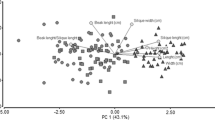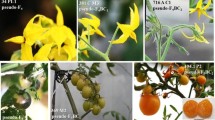Abstract
The commercial and economic value of genetically modified crops is determined by a predictable, consistent and stable transmission and expression of the transgenes in successive generations. No gene inactivation is expected after selfings or crosses with non-transformed plants of homozygous transgenic oilseed rape plants if the expression of the transgene in homozygous or hemizygous nature in such plants is stable. The segregation ratios of phosphinothricin (PPT) tolerance in successive generations of selfings and mutual crosses of a few independent transgenic PPT-tolerant oilseed rape plants indicated a dominant, monogenic inheritance. In within-variety and between-variety crosses no transgene inactivation was observed. However, after selfings and backcrosses with non-transgenic oilseed rape infrequent loss of the expression of the PPT tolerance transgene was observed independent from its homozygous or hemizygous nature. Molecular analysis of PPT-susceptible plants showed that the loss of expression was due to gene inactivation and not to the absence of the transgene. Methylation and co-suppression are mechanisms that might cause reduced or even loss of expression of the transgene in later generations. The implications of this observation for seed multiplication of varieties and breeding activities with transgenic oilseed rape are discussed.
Similar content being viewed by others
References
Alexander, M.P., 1969. Differential staining of aborted and nonaborted pollen. Stain Techn 44: 117–122.
Baranger, A., A.M. Chèvre, F. Eber & M. Renard, 1995. Effect of oilseed rape genotype on the spontaneous hybridization rate with a weedy species: an assessment of transgene dispersal. Theor Appl Genet 91: 956–963.
Block, M. de, J. Botterman, M. Vandewiele, J. Dockx, C. Thoen, V. Gosselé, N. Rao Movva, C. Thompson, M. van Montagu & J. Leemans, 1987. Engineering herbicide resistance in plants by expression of a detoxifying enzyme. EMBO J 6: 2513–2518.
Cherdshewasart, W., G.B. Gharti-Chhetri, M.W. Saul, M. Jacobs & I. Negrutiu, 1993. Expression instability and genetic disorders in transgenic Nicotiana plumbaginifolia Viv. plants. Transgenic Res 2: 307–320.
Conner, A.J. & M.C. Christey, 1994. Plant breeding and seed marketing options for the introduction of transgenic insect-resistant crops. Biocontrol Sci Tech 4: 463–473.
Conner, A.J., L. Mlynárová & J.P. Nap. Meiotic stability of transgene expression is unaffected by flanking matrix-associated regions. Submitted.
Dale, P.J. & J.A. Irwin, 1995. The release of transgenic plants from containment, and the move towards their widespread use in agriculture. Euphytica 85: 425–431.
Deroles, S.C. & R.C. Gardner, 1988a. Expression and inheritance of kanamycin resistance in a large number of transgenic petunias generated by Agrobacterium-mediated transformation. Plant Mol Biol 11: 355–364.
Deroles, S.C. & R.C. Gardner, 1988b. Analysis of the T-DNA structure in a large number of transgenic petunias generated by Agrobacterium-mediated transformation. Plant Mol Biol 11: 365–377.
Finnegan, J. & D. McElroy, 1994. Transgene inactivation: plants fight back! Bio/Techn. 12: 883–888.
Heberle-Bors, E., B. Charvat, D. Thompson, J.P. Schernthaner, A. Barta, A.J.M. Matzke & M.A. Matzke, 1988. Genetic analysis of T-DNA insertions into the tobacco genome. Plant Cell Rep 7: 571–574.
Ingelbrecht, I., H. Van Houdt, M. Van Montagu & A. Depicker, 1994. Posttranscriptional silencing of reporter transgenes in tobacco correlates with DNA methylation. Proc Natl Acad Sci USA 91: 10502–10506.
James, D.J., A.J. Passey & S.A. Baker, 1995. Transgenic apples display stable gene expression in the fruit and Mendelian segregation of the transgenes in the R1. Euphytica 85: 109–112.
Jorgensen, R., 1990. Altered gene expression in plants due to trans interactions between homologous genes. Trends Biotechn 8: 340–344.
Kilby, N.J., H.M.O. Leyser & I.J. Furner, 1992. Promoter methylation and progressive transgene inactivation in Arabidopsis. Plant Mol Biol 20: 103–112.
Koncz, C. & J. Schell, 1986. The promoter of TL-DNA gene 5 controls the tissue-specific expression of chimaeric genes carried by a novel type of Agrobacterium binary vector. Mol Gen Genet 204: 383–396.
Linn, F., I. Heidmann, H. Saedler & P. Meyer, 1990. Epigenetic changes in the expression of the maize A1 gene in Petunia hybrida: role of number of integrated gene copies and state of methylation. Mol Gen Genet 222: 329–336.
Matzke, M.A. & A.J.M. Matzke, 1991. Differential inactivation and methylation of a transgene in plants by two suppressor loci containing homologous sequences. Plant Mol Biol 16: 821–830.
Matzke, M.A., M. Primig, J. Trnovsky & A.J.M Matzke, 1989. Reversible methylation and inactivation of marker genes in sequentially transformed tobacco plants. EMBO J 8: 643–649.
Matzke, M.A., F. Neuhuber & A.J.M. Matzke, 1993. A variety of epistatic interactions can occur between partially homologous transgene loci brought together by sexual crossing. Mol Gen Genet 236: 379–386.
Metz, P.L.J., J.P. Nap & W.J. Stiekema, 1995. Hybridization of radish (Raphanus sativus L.) and oilseed rape (Brassica napus L.) through a flower-culture method. Euphytica 83: 159–168.
Meyer, P., 1995. Variation of transgene expression in plants. Euphytica 85: 359–366.
Meyer, P., F. Linn, I. Heidmann, H. Meyer zu Altenschildesche, I. Niedenoff & H. Saedler, 1992. Endogenous and environmental factors influence 35S promoter methylation of a maize A1 gene construct in transgenic petunia and its colour phenotype. Mol Gen Genet 231: 345–352.
Mittelsten Scheid, O.M., J. Paszkowski & I. Potrykus, 1991. Reversible inactivation of a transgene in Arabidopsis thaliana. Mol Gen Genet 228: 104–112.
Müller, A.J., R.R. Mendel, J. Schiemann, C. Simoens & D. Inzé, 1987. High meiotic stability of a foreign gene introduced into tobacco by Agrobacterium-mediated transformation. Mol Gen Genet 207: 171–175.
Napoli, C., C. Lemieux & R. Jorgensen, 1990. Introduction of a chimeric chalcone synthase gene into Petunia results in reversible co-suppression of homologous genes in plants. Plant Cell 2: 279–289.
Ottaviani, M.P., T. Smits & C.H. Häenisch ten Cate, 1993. Differential methylation and expression of the ß-glucuronidase and neomycin phosphotransferase genes in transgenic potato cv Bintje. Plant Sci 88: 73–81.
Thompson, C., N. Movva, R. Tizard, R. Crameri, J. Davies, M. Lauwereys & J. Botterman, 1987. Characterization of the herbicide resistance gene ‘bar’ from Streptomyces hygroscopicus. EMBO J 6: 2519–2523.
Van der Krol, A.R., L.A. Mur, M. Beld, J.N.M. Mol & A.R. Stuitje, 1990. Flavonoid genes in Petunia: addition of a limited number of gene copies may lead to a suppression of gene expression. Plant Cell 2: 291–299.
Wilmink, A., 1996. Genetic modification of tulip by means of particle bombardment. PhD Thesis, University Nijmegen, The Netherlands, pp. 108.
Author information
Authors and Affiliations
Rights and permissions
About this article
Cite this article
Metz, P.L., Jacobsen, E. & Stiekema, W.J. Occasional loss of expression of phosphinothricin tolerance in sexual offspring of transgenic oilseed rape (Brassica napus L.). Euphytica 98, 189–196 (1997). https://doi.org/10.1023/A:1003117200129
Issue Date:
DOI: https://doi.org/10.1023/A:1003117200129




